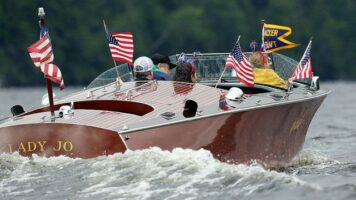
Login
What We Do
The Boating Safety Committee is responsible for overseeing the NYS-mandated Boating Safety Course in coordination with Paul Smiths College, offered annually to Upper Saranac Lake Association members.
New York State Boating Safety Certificate Requirements
A recent change to New York State boating law will require all boat operators, including operators of personal watercraft, to pass a state-approved boating safety course and obtain a boating safety certificate.
- All motorboat operators born on or after January 1, 1978, must have a boating safety certificate beginning January 1, 2024.
- All motorboat operators regardless of age must have a boating safety certificate beginning January 1, 2025.
Boating safety courses are offered online and in-person. Register for the USLA course offered each summer or click here to find a course online or in a location near you.
Boating Safety Resources and Information
New York State Boater’s Guide
While we highlight below the most common New York State legal and safety requirements for boating, boat operators are solely responsible for knowing and complying with all federal, state, and local laws pertaining to the use or operation of watercraft. For legal purposes, the U.S. Federal Code and the New York State Navigation Law should be consulted.
Boating While Intoxicated (BWI)
Boating while intoxicated (BWI) is prohibited on all watercraft. Laws are strict and penalties are severe.
Required Equipment Aboard Vessels
New York State law requires the operators of watercraft to carry certain safety gear aboard their vessels as summarized below. Tickets may be issued to boat operators not in compliance.
Life Jackets
Boat operators must carry one (1) serviceable U.S. Coast Guard (USCG) approved Type 1 Life Jacket of the proper size for each person on board any vessel including canoes, kayaks, rowboats, and sailboats. Life jackets must be readily accessible to everyone on board.
Life jackets are required to be worn by:
- Children under 12 years of age.
- All persons being towed (on wakeboards, water skis, inflatable tubes, parasails, etc.)
- All persons aboard a personal watercraft.
- All persons aboard pleasure vessels less than 21 feet in length between November 1 and May 1.
Throwable Floatation Aid
Vessels 16 feet and greater in length except canoes and kayaks are required to have a USCG-approved Type IV throwable floatation aid on board.
Visual Distress Signals
All vessels 16 feet and greater in length except canoes, kayaks and rowboats are required to carry serviceable USCG-approved day and nighttime visual distress signals.
All personal watercraft are required to carry a USCG-approved daytime visual distress signal.
All vessels regardless of length except canoes, kayaks and rowboats are required to carry serviceable USCG-approved nighttime visual distress signals. While the law exempts canoes, kayaks, and rowboats from this requirement, it is strongly recommended that ALL vessels operating between sunset and sunrise carry nighttime visual distress signals.
Most vessels can meet this requirement by carrying three (3) USCG-approved day/night handheld flares. Consult The New York State Boater’s Guide for other options.
Fire Extinguishers
All mechanically propelled vessels, except outboards less than 26 feet in length and of open construction, must carry one (1) B-I USCG-approved fire extinguisher.
Mechanically propelled vessels 26 feet to less than 40 feet in length must carry two (2) B-I USCG-approved fire extinguishers or one (1) B-II fire extinguisher.
Mechanically propelled vessels 40 feet to less than 65 feet in length must carry three (3) B-I fire extinguishers or one (1) B-II and one B-I fire extinguisher.
Anchor
All mechanically propelled vessels except personal watercraft must carry an anchor and line of sufficient weight and strength to provide the vessel with safe anchorage. The anchor line should be between 7 and 10 times the depth of the water in which the vessel is normally anchored.
Whistle or Horn
All personal watercraft and mechanically propelled vessels 12 meters (39 feet) and greater in length must carry a mechanical device (whistle) capable of producing a blast of two or more seconds in duration audible for one-half mile.
Vessels less than 12 meters (39 feet) must be equipped with a mouth whistle.
Operators of manually propelled vessels, including canoes, kayaks, and paddle boards, must carry a whistle or other means of making a sound signal sufficient to attract attention when in the vicinity of power or sail vessels.
Navigation Lights
All vessels must display their required navigational lights between sunset and sunrise.
Manually propelled vessels, including canoes, kayaks, personal watercraft and sailing vessels less than 7 meters (23 feet) in length may carry, in lieu of fixed lights, a lantern with a white light which can be exhibited in sufficient time to prevent a collision.
Additional Recommended Safety Equipment
Additional Recommended Safety Equipment
- Bilge Pump/Bailer
- Boat Hook
- Compass
- First Aid Kit
- Marine Radio
- Oars/Paddles
- Spare Parts
- Tool Kit
Personal Watercraft
Personal Watercraft
Most provisions of boating law also apply to personal watercraft. The following are specific regulations that apply to their operation:
- Operators must be a minimum of 14 years old with a valid boating safety certificate.
- Operators under 14 years old must be accompanied by an operator at least 18 years old with a valid boating safety certificate.
- Operators must wear a serviceable U.S. Coast Guard (USCG) approved Type 1 Life Jacket.
- Hours of operation are limited to between sunrise and sunset. Installation or use of navigation lights does not permit personal watercraft to be operated between sunset and sunrise.
